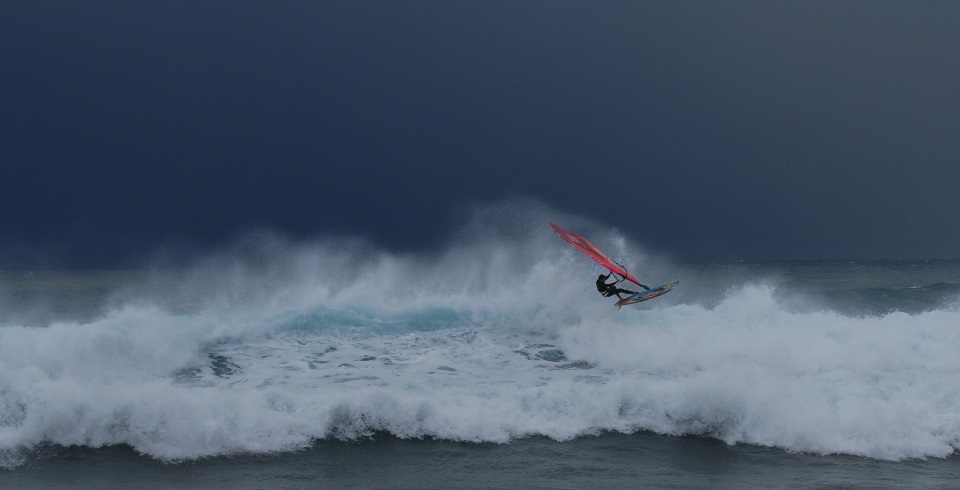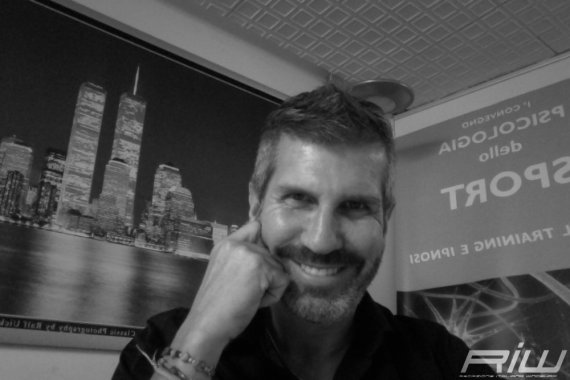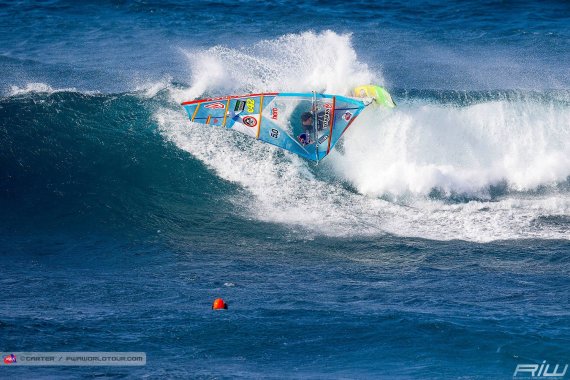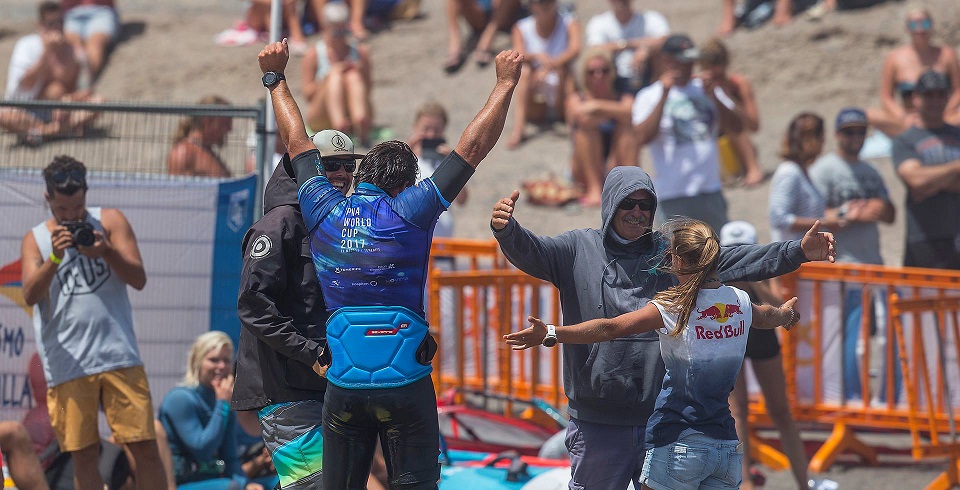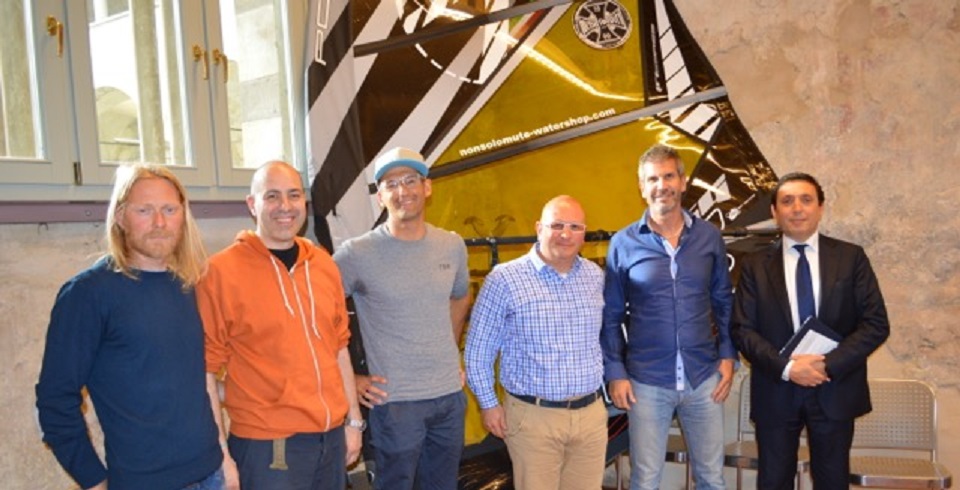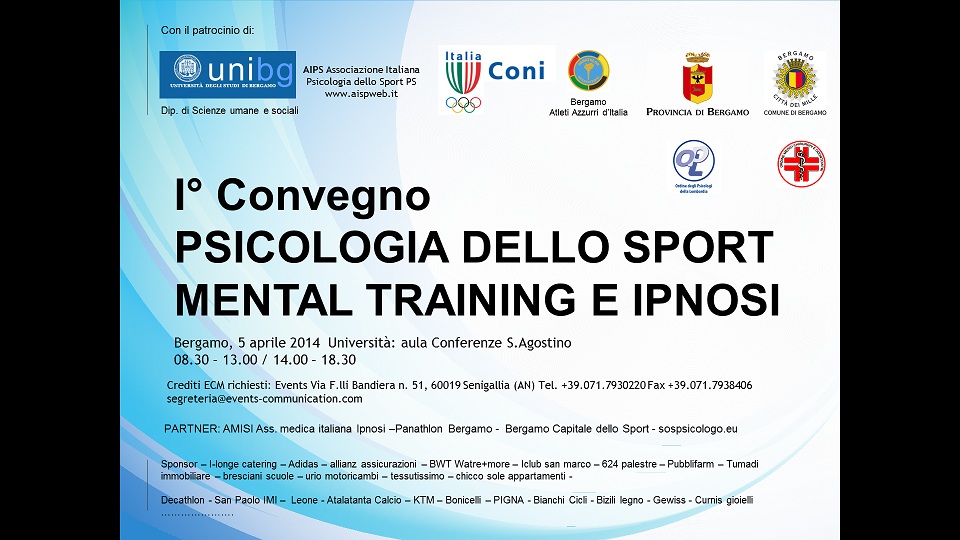Massimo Masserini, atleta regatante italiano di grande spessore tecnico (campione del mondo master slalom IFCA 2006, campione del mondo FW GMaster 2009, CAMPIONE DEL MONDO GMaster FORMULA WINDSURF 2010) ma anche Psicologo Clinico, Psicologo dello sport, Pedagogista, Ipnotista e sessuologo clinico, professore all’universita’ Popolare di Bergamo Nicholas Flamel, ha preparato una nuova puntata per RIWmag.
IL CORONAVIRUS COVID-19 SI COMBATTE CON IL RESPIRO
NOI CHE PRATICHIAMO WINDSURF SIAMO MOLTO ESPERTI DI ARIA E DI VENTO
In questi giorni cosi duri e difficili, la tragedia che stiamo affrontando per il contagio da COVID-19 mette a dura prova il fisico e la parte emotiva di tante persone. Si cerca di dare un contributo, per offrire un po’ di consapevolezza, equilibrio e forza interiore a chi ne ha più bisogno. In questo articolo si descrivono concetti e attività pratiche da utilizzare nei momenti di difficoltà: “l’approccio è che se sei abituato a combattere contro il vento, puoi rinforzarti attraverso il tuo respiro”
Partiamo dall’emozione primaria la Paura e la condizione psicofisica che viene quando la si prova: l’Ansia.
Cosa è la paura?
La paura è una delle sei emozioni di base, è una emozione primaria che è servita alla nostra specie per proteggersi ed ha una funzione evolutiva, il suo compito è attivare le azioni difensive e salvavita, sintetizzabili in lotta, fuga o come ultima possibilità paralisi, per affrontare un pericolo reale, potenziale o immaginario. Quante volte ci si è trovati in condizione di pericolo nel nostro sport: paura della forza del vento, un piedino rotto nella solitudine in mezzo al mare, nuotare in acque che possono essere territorio di animali pericolosi, ma anche paura di fare una manovra o semplicemente paura di non riuscire a vincere una regata.
Quale funzione svolge la paura?
La paura stimola complesse reazioni organiche attraverso espressioni, a intensità variabile, del ramo Simpatico del Sistema Nervoso Autonomo, al fine di preparare l’organismo (corpo e mente) ad affrontare situazione di emergenza dispiegando le migliori risorse a propria disposizione reagendo nei tre modi descritti Attacco, Fuga, Paralisi. Ci tiene lontano dai pericoli, ci fornisce abilità per fare cose eccezionali e in acqua con la nostra tavola e vela ci fa divertire.
La paura ha molti aspetti positivi, cerchiamo di conoscerla:
abbiamo diversi livelli di correlazione e di attivazione:
– livello fisico per una minaccia di una incolumità nel corpo
– livello psicologico per una minaccia emotiva reale o percepita
– livello di intensità: attivazione del SNA (Ortosimpatico, Parasimpatico, Enterico)
– livello di durata dello stimolo
– livello di aspettative e sensazioni piacevoli e/o dolorose
Miscelando e mettendo in correlazione questi livelli, avremo diversi gradi di paura e diverse risposte fisiche ed emotive
Ecco i vari gradi e livelli della paura:
Timore – forma meno intensa, caratteristiche sono: incertezza e mancanza di controllo. Il livello è una minaccia molto bassa e può avere una durata più lunga.
Ansia – Forma più intensa del timore, paura medio-alta a causa dell’incertezza e indeterminazione della minaccia, a volte persino sconosciuta o come in questo periodo: Invisibile. Il ramo OrtoSimpatico viene attivato in stato di allerta con la mente e il corpo vigili e pronti all’azione, anche per lunghi periodi.
Spavento – qui la paura crea un’attivazione più forte del ramo OrtoSimpatico, mobilitando la scarica ormonale di cortisolo e conseguente risposta (STRESS) impiegando risorse energetiche e determinando modificazioni funzionali alla lotta o alla fuga. La minaccia reale o percepita è immediata e la durata sarà limitata al tempo dell’azione e/o reazione allo stimolo.
Panico – qui la paura assume un’intensità tale da provocare la percezione di morte imminente. L’attivazione del sistema OrtoSimpatico può avere un’intensità tale da ostacolare la corretta organizzazione del pensiero e dell’azione, generando situazioni di serio pericolo a causa della reazione emotiva scomposta.
Terrore/Orrore – qui la paura diviene estrema, incontrollabile e irrazionale, tanto che l’impulso di fuggire ovunque come accade nel panico, si può trasformare in immobilità (paralisi). L’attivazione del sistema OrtoSimpatico è tale da farlo sopraggiungere al collasso con conseguente incapacità nell’azione, facendo intervenire in modo esponenziale il sistema Parasimpatico che come ultima possibilità di sopravvivenza abbassa al minimo limite ogni funzione vitale.
Esiste una grande differenza fra l’espressione momentanea di un’emozione e la sua continua manifestazione tanto da divenire stato emotivo persistente e, successivamente, patologia. L’ansia diventa patologica quando le attività psicofisiche associate allo stato ansioso perdurano per tempi molto lunghi rendendo particolarmente difficile, se non impossibile, lo svolgimento delle normali attività quotidiane, in quest’ultimo caso, sarebbe opportuno rivolgersi a un professionista del settore sanitario.
Cosa accade quando senti la minaccia?
Le notizie quotidiane sull’evoluzione dell’epidemia di COVID-19 scatenano continue attivazioni ansiose che potrebbero cronicizzarsi sviluppando patologie e, in casi estremi, possono degenerare in panico. E’ del tutto normale essere preoccupati e in apprensione mentre si ascoltano le notizie del contagio e dei decessi, come è normale avere una certa ansia quando si è costretti a uscire di casa ed entrare in contatto con sconosciuti potenzialmente infetti. Altrettanto normale provare ansia prima di una competizione, ma dopo la partenza tutto sparisce perché si è concentrati sulla prestazione (ansia di stato)
In questi momenti di incertezza e di esposizione potenziale al rischio il sistema nervoso autonomo effettua valutazioni continue sulla sicurezza dell’ambiente, per assicurare la sopravvivenza attraverso la messa in campo di strategie per attivare comportamenti idonei a prevenire situazioni rischiose. Se in situazioni di incertezza e tensione emotiva si sente il battito del cuore accelerato o una pressione sul petto e si è in buona salute, si stanno provando sensazioni associate alla paura ansiosa: non bisogna pensare subito al peggio, è solo il Sistema OrtoSimpatico che sta dispiegando le sue strategie difensive: il respiro diviene corto e aumenta la frequenza, il cuore accelera aumentando i battiti, i sensi divengono sensibilissimi (noti anche il minimo movimento), si sente salire la voglia di scappare (l’adrenalina fornisce tanta energia per fare).
Quando questo accade si deve sapere che l’ansia ci sta trasformando nella più performante espressione di noi stessi per affrontare la minaccia.
Cosa comporta provare la paura da Covid-19?
Sentire la presenza nell’aria, l’imminenza e l’imprevedibilità del pericolo silenzioso e invisibile, genera ansia. Le notizie sul decorso della pandemia da Covid-19 generano un’ansia diffusa, persistente e autoalimentante. Il Sistema OrtoSimpatico percepisce dallo stimolo ambientale (brutta notizia) la necessità di attivarsi e intraprende le attività preparatorie – allerta le sentinelle, dispiega le prime difese e arma alcuni cannoni (ormoni dello stress e glucosio).
Un sistema perennemente attivato, perché continui a informarti dai social o dalla tv a tutte le ore, genererà continue riattivazioni del sistema simpatico innescando un loop disastroso:
- notizia negativa,
- pressione dell’ansia (modificazioni fisiche e mentali),
- attivazione comportamenti protettivi e reattivi,
- scarsa propensione alla socialità (perdita del sorriso),
- perdita dell’appetito e del sonno,
- dopo qualche tempo sensazione di stanchezza, apatia
- corsa a rifornirsi di energia pronta con cibo spazzatura
- tendenza alla dipendenza da sostanze alimentari
Cosa posso fare per allentare la pressione dell’ansia?
Bisogna essere consapevole che per allentare la pressione dell’ansia è necessario attivare una strategia coordinata di comportamenti virtuosi in grado di abbassare il tono del Sistema OrtoSimpatico e riportarlo in equilibrio alzando il livello di quello Parasimpatico.
Equilibrio, lucidità e benessere saranno il premio per aver eseguito il programma in modo corretto. Attività sporadiche non daranno alcun beneficio ma solo un sollievo momentaneo.
1 Identificare
Il primo passo è identificare quale tipo di paura si prova: timore, ansia o spavento?
Per fare questo ci si siede in un luogo tranquillo, silenzioso e familiare, chiudendo gli occhi:
- si prova a dare un nome all’emozione negativa,
- si cerca di avvertire il grado di pressione, dove lo si localizza nel corpo su una scala da 0 a 10,
- da 1 a 3/4 si è in uno stati di timore, da 5 a 6/7 si è in uno stato ansioso, se la pressione è maggiore di 7 si è in uno stato di spavento o forte paura.
Avere consapevolezza del proprio stato emotivo ci può dare molta più sicurezza nel poterlo gestire.
2 Gestire e Trasformare
Si consiglia di fare questo semplice esercizio:
respiro addominale diaframmatico 4-6-2 (4” inspirazione con il naso – 6” respirazione con la bocca – 2” trattengo respiro) e si riparte per 5 minuti
L’obiettivo è riportare il Sistema Nervoso Autonomo in equilibrio, facendo diminuire l’azione del Simpatico e stimolare quella del Parasimpatico, attraverso l’azione ritmica del Nervo Vago.
E’ proprio il Nervo Vago la nostra più grande risorsa nervosa nelle situazioni dove l’ansia e altre emozioni negative tentano di prendere il sopravvento.
Per trasformare la situazione ansiosa si deve stimolare il Nervo Vago in modo ritmico attraverso una respirazione diaframmatica, circolare e lenta e costante.
Sul mercato ci sono vari prodotti che misurano la coerenza cardiaca e la variabilità cardiaca (HRV) indici che ci forniscono indicazioni sul nostro SNA: Inner Balance di selfcoherence.com o dispositivi di biofeedback simili indicano in tempo reale se l’esercizio sta funzionando o meno e adattare la respirazione al tuo naturale ritmo di risposta neurovegetativa.
3 Le 7 Indicazioni dello Psicologo per una sana gestione dell’Epidemia
– Mantenere inalterato il ritmo sonno-veglia
Fondamentale regola da seguire per evitare di incorrere in disturbi del sonno da alterazione del ritmo circadiano: andare a dormire all’ora abituale, così come svegliarsi come siamo abituati a fare con o senza l’ausilio di una sveglia, si può dormire un po’ di più ma non oltre 1/2 ore più del solito orario. Scivolare in un’inversione del ritmo sonno-veglia è più facile di quanto possiamo immaginare.
– Consapevolezza dei giorni della settimana e strutturare le nuove attività
La domenica non è come il lunedì, il mercoledì non è come il sabato. E’ fondamentale ricordarsi di quale sia il giorno che stiamo vivendo e comportarsi di conseguenza cercando di mantenere la solita routine. Si può provare a riprogettare la giornata con le nuove attività cercando di dare sempre una struttura stabile e costante che abbia un senso psicologico e cronologico. Cercare di mantenere le abitudini settimanali consentirà di essere pronti alla ripartenza quando l’emergenza sarà rientrata
– Prendersi cura di se stessi
“Non farsi la barba” “Non curare i capelli” “non fare la doccia” “non lavarsi i denti”. E’ molto Sbagliato! Questo atteggiamento ci fa perdere contatto con la nostra parte sana e ci riporta continuamente alla situazione di emergenza che stiamo vivendo, rendendola ancora più vivida. Rende la persona e chi gli sta accanto in una dimensione a tratti depressivi, spenti e poco sani, contribuendo alla tristezza, noia e apatia.
– Mantenere i contatti sociali.
L’uomo è un “animale sociale”, non possiamo stare gli uni senza gli altri, non ci si può isolare. La socialità è per l’essere umano la prima necessità innata, è intrinseca nella nostra specie. Oggi la tecnologia ci può aiutare a mantenere i rapporti sociali anche se restiamo in casa. Meglio una videochiamata a una chiamata vocale; darà maggior senso di vicinanza e la darà soprattutto alle persone più sole, ai nostri anziani, ai nostri bambini. Si possono organizzare partite a carte con gli amici; ci sono tante applicazioni che aiutano a farlo a distanza; si può un thè con le amiche; gustandolo insieme, chiacchierando via Skype o su altre piattaforme on line…insomma, si può usare la propria fantasia per fare in modo che la tecnologia possa aiutare a conservare passatempi sociali abituali.
– Attività fisica e sana alimentazione
L’attività fisica aiuta a ridurre lo stress e l’ansia; inoltre attiva la chimica della felicità rilasciando endorfine utili alla nostra mente. Si possono trovare numerosi piani di allenamento on line, così come corsi di fitness di ogni genere; fare le faccende di casa o fare piccoli lavoretti di manutenzione, tenere il giardino o sistemare il terrazzo, sono tutte attività che alzano il battito cardiaco oltre la soglia abituale. L’alimentazione deve essere equilibrata in base al consumo giornaliero che evidentemente probabilmente si è ridotto; deve ricca di tutte le sostanze nutritive, Carboidrati e Proteine, nella giusta miscela sono la nostra benzina Calorica.
– Progetti.
Progettare nuove attività, hobbies, leggere libri interessanti, dipingere, studiare o fare corsi on line a distanza. Questo è il momento di farlo! Costruire una sana progettualità, aiuta a sentirsi in contatto con il futuro, alimenta le nostre ambizioni e aiuta la mente a “pensare” al futuro in modo costruttivo e sano. Lasciate uscire i vostro inconscio e cercate si seguire i vostri desideri, passioni. Così potrete produrre dopamina, l’ormone neurotrasmettitore del benessere e serenità.
– Spazio personale, limitando ascolto di notizie, telegiornali e tv
E’ molto utile avere un proprio spazio privato in cui nessuno possa entrare. Anche se la casa è piccola come la maggior parte delle nostre case moderne, e non è disponibile una stanza personale, è necessario prendersi uno spazio/tempo privato, in cui poter riflettere, pensare, meditare, ascoltare musica, leggere un libro, parlare con un amico/amica. Ovviamente sarà utile concordare tempi e modi con i conviventi… limitando l’ascolto di tv, radio e notiziari legati all’Epidemia. E’ utile essere informati, ma non bombardati di notizie, perché questo può aumentare lo stato di allerta e attenzione, creando ansia e tensione emotiva. Meglio sceglier un momento della giornata per le informazioni, è sconsigliato la sera per non avere un sovraccarico di tensione che porterebbe ad un sonno poco ristoratore.
CONCLUSIONE
Questo tragico evento epocale, cambierà molto la società e i rapporti interpersonali, facendoci capire che siamo fragili, e basta una semplice virus a creare morte e disperazione globale. Soprattutto avremo consolidato la consapevolezza che abbiamo sempre bisogno dell’Altro, e che siamo tutti interconnessi. Avremo sicuramente più attenzione per l’ambiente in cui viviamo e la cura del tempo da dedicare agli affetti e all’amore per noi stessi. Infine come sosteneva Lacan, non dobbiamo abbandonare il nostro Desiderio Inconscio, quindi è necessario seguire sempre quella voce interiore del nostro Incoscio, che ci guida nella giusta direzione.
Il mio pensiero e quello di tutto il team di MindFit Clinic va agli amici, ai conoscenti e a tutto il personale sanitario (i nostri EROI) impegnati in prima linea per salvare la vita di migliaia di persone.
Grazie di cuore
Dott Massimo Masserini
www.mindfitclinic.it
text: Massimo Masserini 4 www.RIWmag.com
photo courtesy: JC (c) PWA

